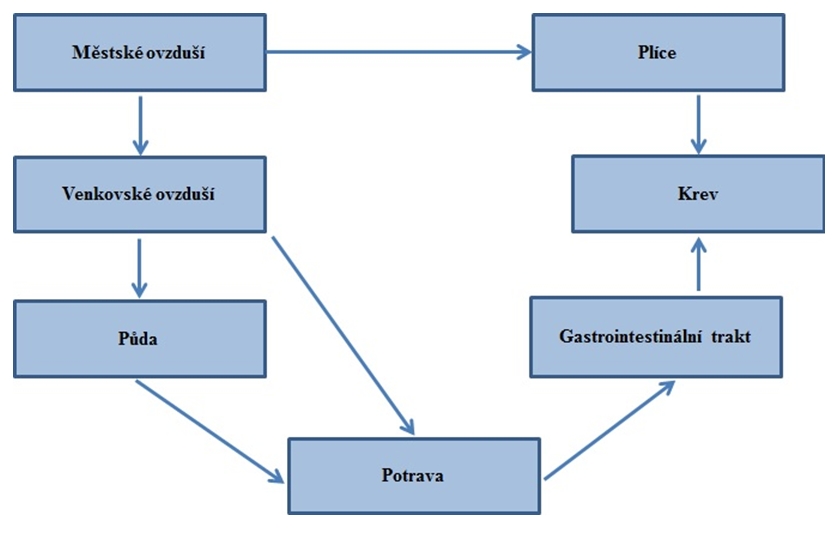
The influence of lead to living organisms
Reneta Kensova, David Hynek, Vojtech Adam, Rene Kizek
This study deals with the role of lead in the environment. It summarizes information about properties of lead and deals with lead intakes into the environment, anthropogenic or natural, and it follows transport of lead between individual components of the environment. Part of this thesis is given to the accumulation of lead into organisms. It points out the toxicity of lead and its effect to human organism. The last chapter summarizes the analytic methods that are commonly used for lead determination.

Fig. 1: Exposure pathways lead from the atmosphere contributing to the levels of lead in human blood
1. ATSDR. (Agency for Toxic Substances and Disease Registry) Toxicological profile for lead (update). U.S. Department of Health and Human Services, Atlanta, GA. 1999.
2. Greenwood, N.N.; Earnshaw, A. Chemistry of the elements, Pergamon Press, 1984.
3. Barta, M. Chemické prvky kolem nás, Edika, 2012, pp. 112 s.
4. Šimek, M. Základy nauky o půdě: Biologické procesy a cykly prvků, Jihočeská univerzita, Biologická fakulta, 2003.
5. Ziegler, E.E.; Edwards, B.B.; Jensen, R.L.; Mahaffey, K.R.; Fomon, S.J. ABSORPTION AND RETENTION OF LEAD BY INFANTS. Pediatric Research. 1978, 12, 29-34.
6. Rutter, M. THE LONG-TERM EFFECTS OF EARLY EXPERIENCE. Developmental Medicine and Child Neurology. 1980, 22, 800-815.
7. Barry, P.S.I. CONCENTRATIONS OF LEAD IN THE TISSUES OF CHILDREN. British Journal of Industrial Medicine. 1981, 38, 61-71 .
8. Kang, H.K.; Infante, P.F.; Carra, J.S. DETERMINATION OF BLOOD-LEAD ELIMINATION PATTERNS OF PRIMARY LEAD SMELTER WORKERS. Journal of Toxicology and Environmental Health. 1983, 11, 199-210.
9. Afridi, H.I.; Kazi, T.G.; Arain, M.B.; Jamali, M.K.; Kazi, G.H.; Jalbani, N. Determination of cadmium and lead in biological samples by three ultrasonic-based samples treatment procedures followed by electrothermal atomic absorption spectrometry. Journal of Aoac International. 2007, 90, 470-478.
10. Afridi, H.I.; Kazi, T.G.; Kazi, A.G.; Shah, F.; Wadhwa, S.K.; Kolachi, N.F.; Shah, A.Q.; Baig, J.A.; Kazi, N. Levels of Arsenic, Cadmium, Lead, Manganese and Zinc in Biological Samples of Paralysed Steel Mill Workers with Related to Controls. Biological Trace Element Research. 2011, 144, 164-182.
11. Blazewicz, A.; Orlicz-Szczesna, G.; Prystupa, A.; Szczesny, P. Use of ion chromatography for the determination of selected metals in blood serum of patients with type 2 diabetes. Journal of Trace Elements in Medicine and Biology. 2010, 24, 14-26.
12. Najafi, N.M.; Massumi, A.; M., S. In Situ Digestion of Serum Samples in Graphite Furnace Prior to determination by ETAAS. Scientia Iranica 2005, 12, 324–328
13. Parsons, P.J. MONITORING HUMAN EXPOSURE TO LEAD - AN ASSESSMENT OF CURRENT LABORATORY PERFORMANCE FOR THE DETERMINATION OF BLOOD LEAD. Environmental Research. 1992, 57, 149-162.
14. Hynek, D.; Prasek, J.; Pikula, J.; Adam, V.; Hajkova, P.; Krejcova, L.; Trnkova, L.; Sochor, J.; Pohanka, M.; Hubalek, J.; Beklova, M.; Vrba, R.; Kizek, R. Electrochemical Analysis of Lead Toxicosis in Vultures. International Journal of Electrochemical Science. 2011, 6, 5980-6010.
15. Krizkova, S.; Zitka, O.; Adam, V.; Beklova, M.; Horna, A.; Svobodova, Z.; Sures, B.; Trnkova, L.; Zeman, L.; Kizek, R. Possibilities of electrochemical techniques in metallothionein and lead detection in fish tissues. Czech Journal of Animal Science. 2007, 52, 143-148.
J.Met.Nano:
volume-1, issue-3
- Personal and professional representation of the nanolabsys project
- Administration and information system of the project
- Microwave preparation of carbon quantum dots with different surface modification
- Cell lines as a model system for quantum dots applications
- Application of quantum dots into chicken embryos
- The influence of zinc to living organisms
- The influence of cadmium to living organisms
- The influence of lead to living organisms
- The influence of mercury to living organisms
- Monitoring of metallothionein levels in biological organism exposed to the metal elements and compounds
- The ratio of GSH/GSSG in biological organisms
- Amino Acids and their interactions with heavy metals
- Antioxidat enzymes – biochemical markers of oxidative stress
- Study of the interaction of quantum dots with tumor cells by fluorescence microscopy
- Flow-cytometric analysis of programmed cell death
- Bacteriophage λ as a doxorubicin nanocarrier
 PDF
PDF